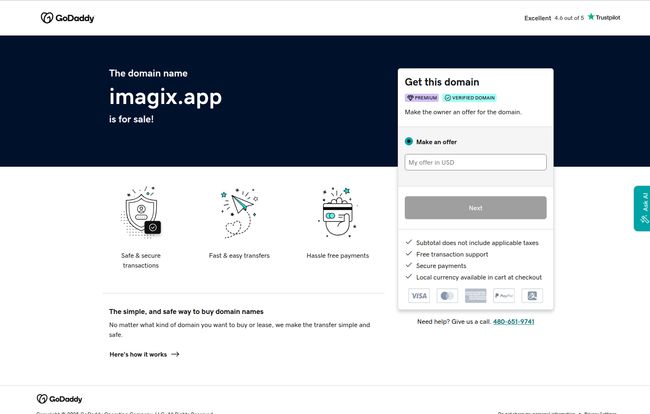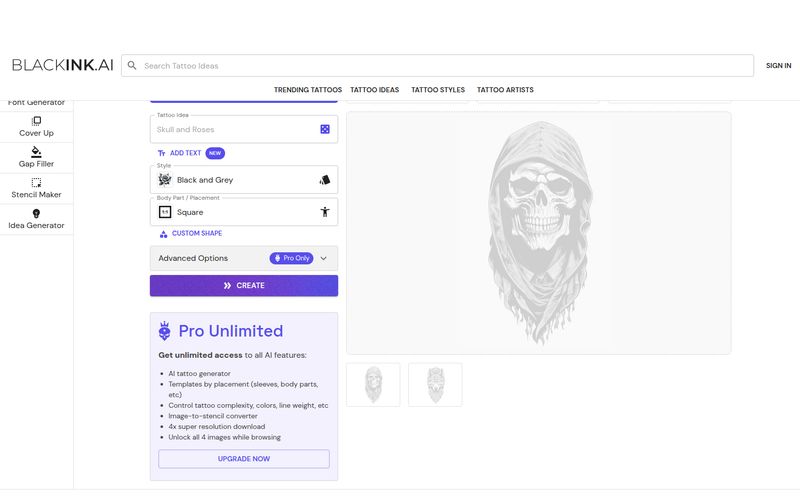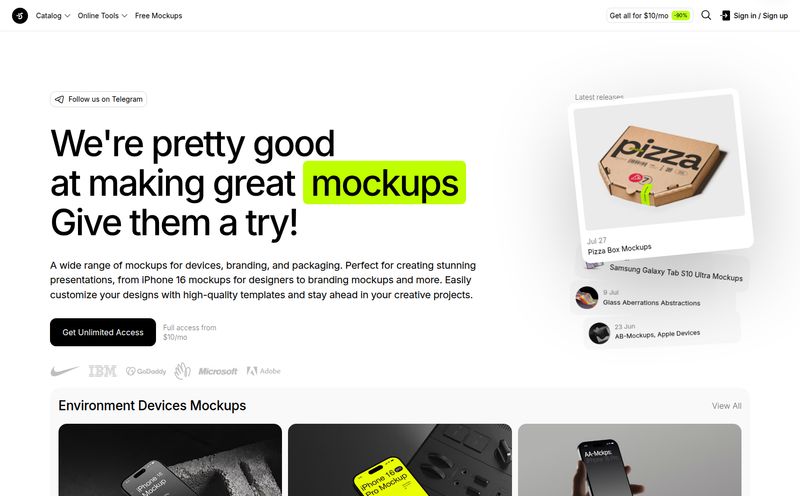There’s a feeling every creative knows. That deep, gut-level dread of the blank canvas. Whether it’s a blinking cursor on a white page, an empty Photoshop artboard, or the first slide of a new presentation, it can be paralyzing. For years, we’ve relied on coffee, long walks, and frantically scrolling through Pinterest to kickstart the ol' noggin. But lately, we've had a new ally in this fight: Artificial Intelligence.
I’m always on the lookout for new tools that can serve as a creative partner, not just a content-churning machine. So when I first heard about Imagix, my interest was definitely piqued. Billed as an AI-powered tool for design inspiration and idea generation, it sounded like the perfect antidote to creative block. It promised to be less of a robot artist and more of a digital muse.
But here’s the thing. As I went to check it out again, I hit a wall. A GoDaddy landing page, to be precise. The domain, imagix.app, is up for sale. A digital ghost town where a promising startup used to be. So what happened? Let's piece together the story of what Imagix was, what it promised, and what its disappearance tells us about the crazy, fast-moving world of AI tools.
What Was Imagix AI Supposed to Be?
From the digital breadcrumbs it left behind, Imagix wasn’t trying to be another Midjourney or DALL-E. It wasn’t about creating photorealistic final images that you’d pass off as your own. Instead, it was positioned as an inspiration engine. Think of it as a creative sparring partner that never gets tired of your weird ideas.

Visit Imagix
The core idea was to blend human creativity with AI innovation. You wouldn't just give it a prompt and get a finished product. You'd use it to explore concepts, generate unique illustrations to get the ideas flowing, and find new creative directions. The platform was still in Beta, which is pretty standard for ambitious tech, but the concept felt solid. It was for the start of the project, not the end. A subtle but important distinction.
The Core Features That Sounded Promising
So what was actually under the hood? Based on its initial specs, Imagix had a few tricks up its sleeve designed to get you unstuck.
AI-Powered Design Inspiration
This was the main event. Instead of just browsing static images, Imagix aimed to generate a stream of concepts, color palettes, and stylistic ideas based on your input. It’s like a mood board that actively collaborates with you. For an SEO guy like me who often has to mock up ad creatives or blog banners, the idea of an instant idea-generator is incredibly appealing. It saves that initial hour of just staring at the screen.
Logo Generation and AI Illustrations
Yes, it could generate logos and illustrations, but the context here is key. The platform's own description suggested this was for inspiration. You wouldn't use the AI-generated logo for your new multi-million dollar brand. But you absolutely could use it to brainstorm ten different conceptual directions in ten minutes. It’s about quantity of ideas, so you can find the quality yourself. A massive time-saver for agencies and freelancers in the early stages of a branding project.
Curated Prompts and Resources
This is a feature I really wish I could have played with. Imagix apparently offered curated prompts and trend resources. This is pure gold. Overcoming the "blank prompt" anxiety is just as hard as overcoming the blank canvas. Having a tool that not only generates content but also helps you ask the right questions is a huge advantage. It's the difference between a tool and a partner.
The Imagix Pricing Model: Pay-As-You-Create
One of the more interesting aspects of Imagix was its pricing. In a world dominated by monthly subscriptions (looking at you, Adobe), Imagix went with a credit-based, pay-as-you-go system. I've always been a fan of this model for tools I don't use every single day.
The breakdown was pretty straightforward:
| Price | Credits | Cost per Credit (Approx.) |
|---|---|---|
| $5 | 70 Credits | ~$0.07 |
| $10 | 160 Credits | ~$0.06 |
| $15 | 250 Credits | ~$0.06 |
This structure is perfect for the occasional user—a blogger, a social media manager, or a small business owner who needs a creative boost once or twice a month without committing to a $20/month subscription. Of course, the link to their pricing page now leads to that GoDaddy offer, a silent testament to a business plan cut short.
The Big Caveat: Inspiration, Not Implementation
It's important to circle back to a key point in Imagix's own description: it was for inspiration purposes only and didn't provide finished products. Some might see this as a huge drawback. Why use a tool that doesn't... finish the job? But in my experience, that was its biggest strength.
AI-generated art can sometimes feel a bit generic, a little soulless. It can lack the specific spark of a human designer. By positioning itself as a brainstorming tool, Imagix smartly sidestepped that problem. It gave you the starting point, the spark, the rough sketch. The final masterpiece, with all its nuance and human touch, was still up to you. This is the sweet spot for many creative professionals I know. We don't want to be replaced; we want to be augmented.
So, What Happened to Imagix.app?
This is the million-dollar question. Or, more accurately, whatever price GoDaddy is asking for the domain. When a promising startup's domain suddenly goes up for sale, it usually means one of a few things:
- They ran out of runway. The most common story in the startup world. They had a great idea but couldn't secure funding to keep the servers running and the team paid. The Beta phase is expensive.
- They got acqui-hired. A larger company might have bought them not for the product, but for the talented team behind it. The original project gets shut down as the team is absorbed to work on something else.
- They pivoted and forgot to redirect. It's possible they rebranded to a new name and domain and just... dropped the ball on redirecting the old one. A rookie SEO mistake, but it happens more often than you'd think.
- It was just a project that the founder moved on from. Sometimes these tools are passion projects that just don't get the traction the creator hoped for.
Whatever the reason, it's a shame. The idea behind Imagix is more relevant than ever. We need more AI tools that focus on augmenting creativity rather than just automating it.
A Lesson in the Volatile World of AI Startups
The story of Imagix, or the lack thereof, is a perfect snapshot of the current AI landscape. It's the Wild West all over again. Tools and platforms are popping up and disappearing overnight. It’s exciting, but it’s also a bit chaotic. It serves as a reminder to not get too attached to any single new tool, especially one that's in beta.
While we may never get to use Imagix as it was envisioned, the concept remains powerful. The need for a true AI brainstorming partner is real. For now, we'll have to keep our eyes peeled for the next startup that tries to build a muse in a bottle. Hopefully, that one remembers to renew its domain registration.
Frequently Asked Questions
- What was Imagix AI?
- Imagix AI was designed to be an AI-powered inspiration tool for creatives. Its goal was to help users generate ideas, concepts, and illustrative starting points for design projects, rather than producing finished assets.
- Was Imagix free to use?
- Imagix operated on a pay-as-you-go credit system. It was not free, but it offered affordable credit packs starting at $5 for 70 credits, making it accessible for occasional use without a monthly subscription.
- What made Imagix different from other AI image generators?
- Its primary focus was on the ideation and inspiration phase of the creative process. Unlike tools like Midjourney that aim to create finished, high-quality images, Imagix was positioned as a brainstorming partner to help overcome creative blocks.
- Can I still access Imagix AI?
- No. As of late 2024, the domain imagix.app is for sale on GoDaddy, and the service is no longer active. The original platform is not accessible.
- Are there any good alternatives to Imagix?
- While Imagix's specific "inspiration-first" angle was unique, you can achieve similar brainstorming results using mainstream AI image generators. Try using prompts geared towards concepts, sketches, or mood boards, like "conceptual logo ideas for a coffee shop, line art style" or "mood board for a tech startup, colours blue and orange, minimalist aesthetic." Tools like Pinterest's collage tools and Milanote also remain excellent for manual mood boarding.
Reference and Sources
- Imagix Pricing Information (Archived):
https://www.imagix.app/pricing - Domain Sale Listing:
https://www.godaddy.com/domain-auctions/imagix-app-422177651



